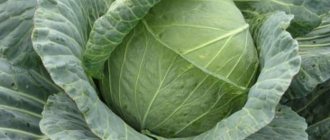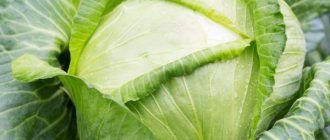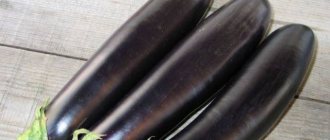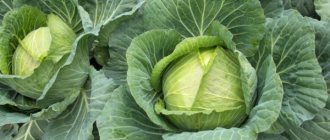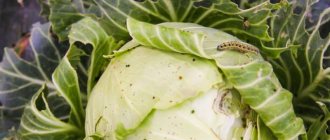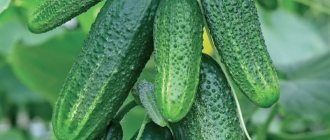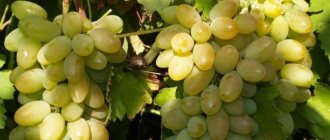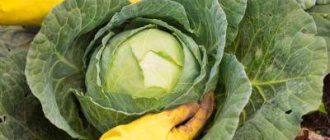Valentina cabbage is a late-ripening hybrid. Developed by breeders at the station named after N.N. Timofeeva. In 2004 it was added to the State Register of the Russian Federation and recommended for cultivation in the following regions of the country:
- Central Chernozem.
- North Caucasian.
- Volgo-Vyatsky.
- Central.
- Northern.
- Far Eastern.
- East Siberian.
- North-West.
- West Siberian.
- Uralsky.
The authors are D.V. Patsuriya, G.F. Monakhos, A.V. Kryuchkov. Valentina is perfect for both growing on a personal plot (for home use) and for growing on an industrial scale (for sale on the market).
Description of cabbage hybrid Valentina F1
The hybrid is easy to grow and has a shelf life of up to 7 months. Vegetables are formed dense, and with proper care they rarely crack.
Origin and development
The productivity and possibility of growing the hybrid in many climatic zones has been proven by trial tests. In 2004 it was included in the State Register of Russia.
Cabbage was bred in Moscow, at the N. N. Timofeev Breeding Station. The authors of the hybrid are Kryuchkov A.V., Patsuria J.V., Monakhos G.F.
Chemical composition and beneficial properties
Cabbage contains a large amount of vitamins and minerals. Basic:
- vitamins C, B1, B2, B4, B5, B6, B9, PP, K, U;
- silicon;
- manganese;
- potassium;
- calcium;
- iron;
- iodine;
- boron;
- phosphorus;
- sodium.
Beneficial features:
- stabilization of the gastrointestinal tract;
- reduction of inflammatory processes;
- regulation of blood cholesterol levels;
- prevention of atherosclerosis;
- removal of toxins;
- normalization of the cardiovascular system;
- weight loss (calorie content of cabbage is 24 kcal per 100 g).
The vegetable is forbidden to be consumed by people suffering from chronic gastrointestinal diseases, colic and pancreatitis, especially when they are aggravated.
Features of application
Cabbage is suitable for consumption both fresh and after heat treatment. Heads of cabbage are suitable for canning, pickling, and are stored until a new harvest is obtained.
Ripening time and yield
This is a late-ripening hybrid. Ripening time is from 140 to 180 days. 680–800 centners of vegetables are obtained from 1 hectare.
Resistance to disease and cold
The hybrid is resistant to blackleg, Alternaria, white and gray rot, vascular bacteriosis, fusarium.
Adult plants can withstand frosts down to -8°C, seedlings - up to -3°C.
Characteristics of Valentina cabbage
The hybrid heads are large, round and dense, weighing 3.2–3.8 kg each. The stump is white, the outer one is medium, the inner one is short. Raised leaf rosette type. The leaves are slightly wavy along the edges, pale green and dark green, covered with a pronounced waxy coating.
Reference! Cabbage initially has a bitter taste, but it completely disappears during storage. It is better to consume the heads of cabbage after three months in storage. During this time they will become tender, juicy and sweet, without rough veins.
Vegetables retain their taste and commercial quality for up to 7 months, withstand transportation well, and do not crack.
For which regions is it best suited?
The hybrid is suitable for cultivation in the Volga region, Siberia, the Urals and the Far East, in the Northern, Northwestern, Central, Central Black Earth and North Caucasus regions of Russia. Undemanding to growing conditions.
Similar varieties
Megaton F1 cabbage is similar to Valentina F1 in that both of these varieties are winter-hardy, have high yields, excellent taste and a number of useful vitamins.
- Another variety that has something in common with Valentina F1 is Aggressor cabbage . Late-ripening species, quite frost-resistant. Just like Valentina, it is stored for a long time. Famous for its productivity.
- Kolobok cabbage - has no bitterness, is also considered a late variety, which takes about 150 days to ripen. It is stored for 7-8 months, which means, like Valentina, it is resistant to long-term storage.
- Late Moscow cabbage is one of the late-ripening varieties with good yield. It has an elegant presentation and pleasant taste. This cabbage contains a lot of sugar and ascorbic acid.
Late-ripening varieties of cabbage also include Amager, Sugarloaf, Slava and Zimovka.
Main advantages and disadvantages
Advantages of a hybrid:
- frost resistance;
- high yield rates;
- long shelf life of the crop;
- strength of heads of cabbage;
- resistance to black leg, Alternaria, white and gray rot, vascular bacteriosis, fusarium;
- fork strength due to short stem;
- versatility of application.
Flaws:
- demands on soil: grows on loam and peat;
- intolerance to frequent watering and heat;
- love of light.
Differences from other varieties and hybrids
Features of the hybrid: 90% yield of marketable products, resistance to frost, long shelf life of the crop. If other types of cabbage are ready to eat immediately after harvesting, then Valentina requires aging.
Features of planting and growing
The quality of the harvest depends on the timing of planting, proper soil preparation, and subsequent care.
Preparing for landing
The hybrid is grown by seedlings. The seed sowing date is chosen so that the seedlings are 35 days old before being transferred to open ground. The manufacturer of the planting material is taken into account: it is better to give preference to well-known companies.
Step-by-step seed preparation:
- Healthy seeds are pre-selected. To do this, the material is placed in cold water. Floated specimens are removed as they will not sprout.
- The seeds are placed in a humate solution (prepared strictly according to the manufacturer’s instructions) for 12 hours, then they are hardened at a temperature of +1°C. This stimulates them to intensively germinate and increases cold resistance.
Suitable soil mixture options: 3 kg of peat, 1 kg of turf soil, 300 g of river sand or 2 kg of humus, 2 kg of turf soil, 200 g of sand.
Containers for seedlings can be either shared or individual. Add complex fertilizer (for example, “Purshat-M”) to the soil and moisten everything well. Distribute the seeds evenly, sprinkle them with a 1 cm layer of soil. Moisten them with a spray bottle. Cover with polyethylene or glass and place in a warm place.
Attention! The normal day length of cabbage is 12 hours. Therefore, it is advisable to provide additional lighting to the seedlings. This will help prevent the plants from being pulled out.
After 5 days, shoots will appear. The cover is removed and the container is placed in a well-lit place.
Preparing seedlings
15 days after emergence, healthy plants form 2 leaves. If the seeds were planted in one container, proceed to picking. To do this, cabbage is transplanted into spacious peat pots or plastic cups. 2-3 days before the procedure, the seedlings are well watered.
Each plant is taken along with a lump of earth, 1/3 of the main root is removed so that the root system grows. Deepen into the prepared soil mixture up to the cotyledon leaves. The composition of the soil is identical to the mixture for seeds.
Advice! After picking, the plants are watered only after 5-6 days. As a result, lateral roots will grow, and the cut one will not rot.
Cabbage is planted in open ground in early May. The dimensions of the holes are 30x30 cm, the distance between them is 50 cm, between the rows is 70 cm. Soil preparation and subsequent care are the same as for the seedless method.
Planting
Late varieties are sown in late March-early April. Seeds are immersed in a greenhouse or box to a depth of 1 cm, then watered and placed in a warm place. After about a week, shoots appear. This is the case with Valentina F1 cabbage. Reviews say that the seeds have a germination rate of about 100%. In the cotyledon phase, they are dived into another container. Plants with four true leaves are planted in a permanent place at the end of May, 40 days after sowing. They are placed on the bed according to the 60×60 pattern. Planting according to the 70×50 pattern is allowed. Immerse in soil until the first true leaf. Then the Valentina F1 cabbage will quickly take root in the new place.
Reviews from some gardeners advise sowing cabbage permanently in holes, covering them, if necessary, with film or agrofibre from frost. Place several seeds at a time. Then the extra ones (if any) dive into other holes. Reviews claim that plants that have not been replanted require less watering. But other gardeners say that when diving, part of the root is torn off, causing it to grow wider rather than deeper. This promotes the formation of a larger head of cabbage.
Cabbage is a plant that needs regular watering. It is especially necessary to actively replenish the supply of moisture during the formation of a head of cabbage. The area where cabbage grows is regularly weeded and loosened to improve aeration. Sprinkle the soil with ash to prevent the appearance of aphids and cabbage flea beetles.
Read also: Caring for hazel (hazelnuts) – pruning and shaping –
The first time feeding is carried out after the appearance of the second true leaf. Next time - a couple of days before landing at a permanent place.
How to plant without seedlings
This method is used by experienced gardeners. The requirements here are much greater than those of the seedless method.
Soil requirements
The following factors are taken into account:
- Cabbage grows well in loose, moist and fertile, neutral or slightly alkaline soil.
- Heavy and acidic soil is improved in advance to pH 7. To do this, add 2 tbsp. ordinary chalk or dolomite flour per 1 m2 of area. Add a bucket of humus or compost for every 1 m2.
- They dig up the soil well on the bayonet of a shovel. Be sure to remove all weeds and pest larvae.
- Cover with dark cloth before planting seeds or seedlings.
- If cabbage is grown in a greenhouse, the soil is prepared according to the same principle, but additionally 1 liter of stove ash is added per 1 m2.
It is forbidden to add fresh manure to the soil: mature cabbage will absorb bitterness, become infected with various diseases, and attract insects.
Predecessors
Good predecessors for the crop are potatoes, cucumbers, tomatoes, and onions.
You cannot grow Valentina after radishes, radishes, rutabaga, turnips, horseradish, carrots, zucchini, pumpkin, other hybrids and varieties of cabbage (permissible once every 4 years).
Dates, scheme and rules of planting
Seeds are sown in early or mid-April - early May. The soil temperature should be +6°C, air temperature - +10°C.
The seeds are arranged in rows. The distance between plants should be 1.5-2 cm, between grooves - 2 cm, depth - 1-1.5 cm. Place 2-3 grains in each hole. After germination, only 1 strong plant is left.
Features of cultivation
The recommendations are as follows:
- At first, the ridge is covered with a thick film;
- on warm days the material is opened slightly;
- follow the rules of care;
- provide at least 12 hours of daylight;
- For better plant development, a heating system is installed in the greenhouse.
Nuances of care
Regardless of the chosen method of planting cabbage, there are uniform care rules. They include maintaining the watering regime, hilling, pest and disease control, and fertilizing.
Watering mode
Adviсe:
- water the cabbage 2 times a day in the heat; in the rainy season, irrigation is excluded;
- moisten the plants only in the morning or evening with warm water, consumption - 20 liters per 1 m2 of area in sunny weather, 15 liters - in cloudy weather;
- prevent stagnation of water and drying out of the soil.
Watering is completely stopped a month before harvest, in hot summers - 20 days. This will prevent the heads of cabbage from cracking.
Loosening and hilling
Loosen the soil to a depth of 6 cm after each moistening. Hilling is required 2 times during the entire period of crop growth. The first procedure is carried out 7 days after planting in open ground, the second - during the formation of heads of cabbage.
Top dressing
The hybrid requires 4 feedings per season:
- 2 weeks after planting in open ground. To do this, dilute 0.5 liters of bird droppings or cow manure in 10 liters of water. Apply 0.5 liters to each bush. Mineral remedy: dilute 10 g of urea, 20 g of superphosphate, 10 g of potassium monophosphate in 10 liters of water. The expense is the same.
- 2 weeks after the first fertilizer, dilute 0.5 liters of bird droppings in 10 liters of water, pour 1 liter under each plant.
- 20 days after, dissolve 15 g of potassium monophosphate and 0.5 liters of cow manure in 10 liters of water. Consumption - 1.5 liters of mixture per plant.
- After 3 weeks, fertilizing is applied according to the previous scheme.
Valentina F1 cabbage loves organic fertilizers, but when using one type of fertilizer, it is not recommended to apply others. If organic ones are used, then mineral ones are excluded.
Measures to increase yield
Complex fertilizers will help increase the yield. Use them strictly according to the instructions.
Organic substitutes: “Biud”, “Bucephalus”, “Kaury”, mineral ones: “Hera”, “Cabbage”, “Agricola”, “Kaliyphos-N”.
Disease and pest control
The hybrid is resistant to all types of diseases, but is often affected by blossom end rot. The disease is caused by cabbage fly larvae. Signs: death of the upper leaves, damage to neighboring crops. For prevention, the amount of fertilizing is controlled, nitrogen fertilizers are excluded, and pests are destroyed in a timely manner. For treatment, 300 g of phosphorus flour is added per 1 m2 of area, and the soil around the plants is treated with tobacco dust.
Pests:
- Cruciferous flea beetle. Signs include holes in the leaves and complete destruction of foliage. Insecticides used against insects are: “Aktellik”, “Bankol”, “Karate”, “Decis”, “Bi-58”. Diluted according to instructions.
- White butterfly. Signs include cut leaves, pupae on nearby tree trunks and fences. Control: manual collection of caterpillars, use of the drug “Iskra DE” (1 tablet diluted in 10 liters of water).
- Slug. Signs: blackening of stems and leaves, death of plants. Control - manual collection, 12% hexachlorane solution at the root according to the instructions.
- Cabbage fly . Signs: wilting of plants due to damage to the roots by small white worms. To combat, use a 12% hexachlorane solution under the roots strictly according to the instructions.
- Scoop. Signs: large leaves eaten. Fight - manual collection of larvae, use of the drug "Karate Zeon".
Planting in a permanent place, in open ground
Soil selection and preparation
Valentina is very fond of loams, soils that are able to retain moisture well. It is better to prepare a place for it in the autumn. After the crop from the garden has been completely harvested, the soil is loosened, and after 14 days, when weeds appear, it is dug up. In spring, fertilizers must be applied. There can be several ways:
- In autumn, chalk, fluff, and dolomite flour are used as fertilizers in the amount of two glasses of 250 ml. In the spring, one bucket of humus or compost, two tablespoons of nitrophoska or superphosphate, one teaspoon of urea and two faceted glasses of ash per square meter are distributed over the ridge.
- When digging up the soil in autumn, add one and a half buckets of humus or compost, one tablespoon of potassium sulfate, two tablespoons of superphosphate per square meter.
- Exclusively in the spring, before planting, it is recommended to add a mixture of 0.5 kg of humus, one teaspoon of nitrophoska, two tablespoons of wood ash into each hole, carefully move everything and pour in 0.5 liters of water.
Disembarkation
The cabbage seedling must be strong and healthy when planted.
The event takes place around the fifth of June. Here you need to make sure that the young plants already have six true leaves and are no lower than 16 cm. The planting scheme for Valentina is 70x40, no more than four plants should be planted per square meter, cabbage does not like thickening.
It is recommended to bury the seedlings at the first true leaf; do not allow soil to get into the middle, where young leaves are formed. It is better to plant in the evening or at any time, but in cloudy weather, immediately provide abundant watering - in wet weather - half a liter per plant, in dry weather - one liter.
It is better to plant seedlings on a flat surface that is well lit by the sun at any time of the day. The beds where legumes, cereals, onions, carrots, tomatoes or potatoes used to grow are ideal, but the place where cruciferous vegetables (radish, rutabaga, mustard, turnips) grew is not at all suitable due to the accumulation of pests and diseases. Cabbage is grown in the same place no more than once every four years.
Video: planting white cabbage seedlings
Tips and reviews from experienced gardeners
Experienced gardeners follow some tricks:
- Chop the roots with a shovel or lightly roll the head of cabbage in the ground until the roots crunch. This will weaken the flow of juices from the roots to the leaves so that the heads of cabbage do not crack.
- Do not tear off the lower leaves. Only yellow and dried ones are removed.
- During frosts, when the harvest begins, the head of cabbage is not separated from the roots. This prevents the formation of layers of dry and wet leaves. It is better to wait for warm weather and dig up the plant.
Reviews from gardeners about Valentina F1 cabbage:
Natalya, Novosibirsk: “This is an excellent hybrid with excellent keeping quality. Juicy and sweet cabbage does not lose its taste during the entire storage period. I recommend wrapping the heads of cabbage for the winter.”
Anastasia, Ufa: “Valentina cabbage is a hybrid, not a variety, which I really liked for its high yield. The heads of cabbage turned out dense and juicy, and did not deteriorate over the winter. A new harvest is coming soon, but the old one is still lying around.”
This is interesting:
Early maturing cabbage hybrid Krautkaiser F1, suitable for long-term storage
Simple and tasty recipes for making sauerkraut with vinegar
Proven ways to keep cabbage fresh on the balcony in winter
Harvesting
Harvesting of Valentina cabbage occurs on the tenth day of October
Harvesting of Valentina cabbage begins in mid-October, and is done in one go. Harvesting is recommended in clear, dry weather. As a rule, the temperature at this time fluctuates between 2–6 °C during the day and at night around 0 °C.
Mature heads of cabbage can be cut with a knife or pulled out by the roots. The stalk should only be left with a straight cut at least five centimeters long - then damage during transportation will be avoided.
Before removing the heads of cabbage to a permanent storage location, they must be sorted: less damaged, healthy vegetables should be put aside for a long stay in the cellar, and heads of cabbage with mechanical or other defects should be used first, for example, for winter preparations.
Typically, cabbage is stored on racks, laid in 3 layers, at a temperature of about 0°C and a humidity of 90%.
There is another way to store heads of cabbage. They are laid out in wooden boxes and placed on wooden racks located at a height of 20 cm from the floor. You can wrap each fork in thick paper.
Valentina does not require any special manipulations to increase shelf life, as she feels great until the end of May and retains all her qualities. Valentina is not afraid of rot that threatens cabbage.
